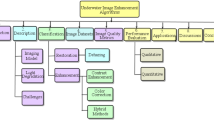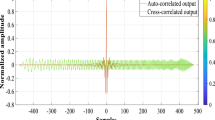Abstract
In underwater target detection, the bottom reverberation has some of the same properties as the target echo, which has a great impact on the performance. It is essential to study the difference between target echo and reverberation. In this paper, based on the unique advantage of human listening ability on objects distinction, the Gammatone filter is taken as the auditory model. In addition, time-frequency perception features and auditory spectral features are extracted for active sonar target echo and bottom reverberation separation. The features of the experimental data have good concentration characteristics in the same class and have a large amount of differences between different classes, which shows that this method can effectively distinguish between the target echo and reverberation.
Similar content being viewed by others
References
Allen N, Hines PC, Young VW (2011). Performances of human listeners and an automatic aural classifier in discriminating between sonar target echoes and clutter. The Journal of the Acoustical Society of America, 130(3), 1287–1298.
Chen Shixiong, Gong Qin, Jin Huijun (2008). Gammatone filter bank to simulate the characteristics of the human basilar membrane. Journal of Tsinghua University (Science & Technology), 48(6), 1044–1048. (in Chinese)
Ma Yuanfeng, Chen Kean, Wang Na (2008). The study of loudness’ calculation based on Moore’s model. Technical Acoustics, 27(3), 390–395. (in Chinese)
Moore BCJ, Glasberg BR (1996). A revision of zwicker’s loudness model. Acustica United with Acta Acustica, 82(2), 335–345.
Moore BCJ. Glasberg BR (2004). A revised model of loudness perception applied to cochlear hearing loss. Hearing Research, 188(1–2), 70–88.
Slaney M (1993). An efficient implementation of the Patterson-Holdsworth auditory filter bank. Technical Report No. TR-35, Apple Computer Inc.
Tucker S, Brown GJ (2003). Modelling the auditory perception of size, shape and material: Application to the classification of transient sonar sounds. The 114th Audio Engineering Society Convention, Amsterdam, 1–12.
Tucker S, Brown GJ (2005). Classification of transient sonar sounds using perceptually motivated features. IEEE Journal of Oceanic Engineering, 30(3), 588–600.
Van Immerseel L, Peeters S (2003). Digital implementation of linear Gammatone filters: Comparison of design methods. Acoustics Research Letters Online, 4(3), 59–64.
Wang Yang, Sun Jincai, Chen Kean (2006). Feature extraction of underwater targets based on psychoacoustic parameters. Journal of Data Acquisition & Processing, 21(3), 313–317. (in Chinese)
Wang Na, Chen Kean (2006). Investigation on underwater target recognition based on auditory characteristics. Proceedings of ASC 2006 Chinese Acoustic Academy Conference, Beijing, 413–414. (in Chinese)
Young VW, Hines PC (2007). Perception-based automatic classification of impulsive source active sonar echoes. The Journal of the Acoustical Society of America, 122(3), 1502–1517.
Yang Yang (2012). The feature extraction and classification of active sonar echoes based on timbre parameters. M.E thesis, Harbin Engineering University, Harbin. (in Chinese)
Zheng Wen, Chen Kean, Ma Yuanfeng (2007). Key problem of calculation of loudness based on Moore’s model. Audio Engineering, 31(6), 11–13. (in Chinese)
Author information
Authors and Affiliations
Corresponding author
Additional information
Foundation item: Supported by the National Natural Science Foundation of China (Grant No.51279033).
Xiukun Li was born in 1962. She is a professor at Harbin Engineering University. Her current research interests include underwater acoustic signal processing, underwater buried object detection, sonar array signal processing and pattern recognition, etc.
Rights and permissions
About this article
Cite this article
Li, X., Meng, X., Liu, H. et al. Classification of underwater target echoes based on auditory perception characteristics. J. Marine. Sci. Appl. 13, 218–224 (2014). https://doi.org/10.1007/s11804-014-1239-9
Received:
Accepted:
Published:
Issue Date:
DOI: https://doi.org/10.1007/s11804-014-1239-9




